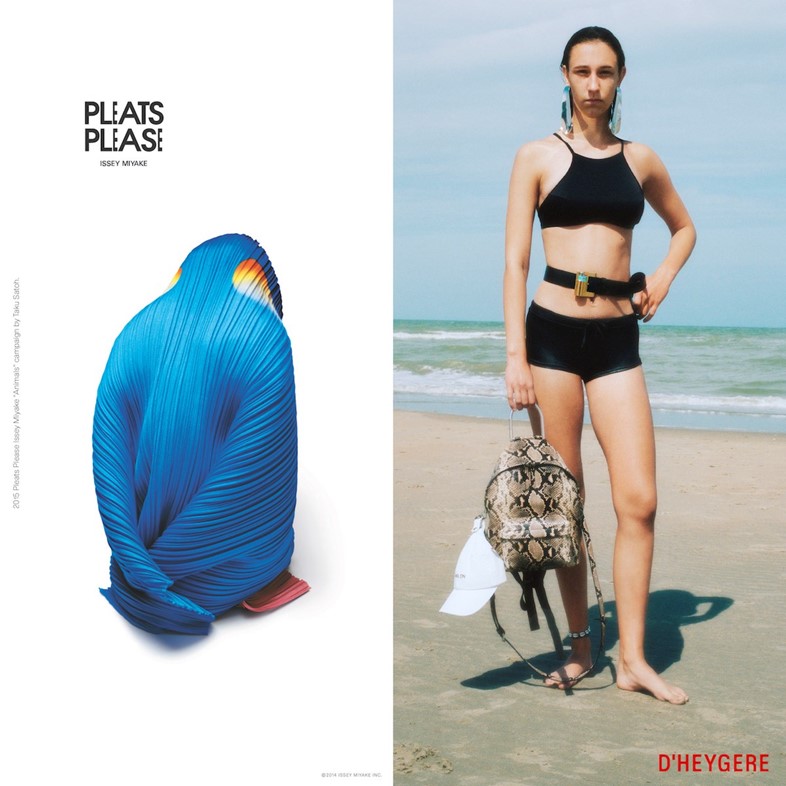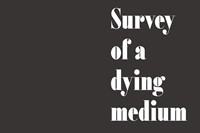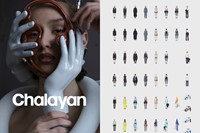The latest issue of Elise By Olsen’s Wallet launches today, titled Master of Marketing. Here, we publish an exclusive extract – an interview with Pierre Rougier, the founder of the influential communications agency PR Consulting
Wallet is the pocket-sized publication by Norwegian editor and publisher Elise By Olsen – who also guest edited AnOthermag.com for a week last summer – which establishes a critical dialogue around contemporary fashion, from theory to business, retail to politics. The latest issue, which launches today, is titled Masters of Marketing, exploring the field of fashion promotion. “We will peek into the ‘privileged room’ of fashion promotion and advertising – and track the evolution from print advertising to digital PR, contemporary brand imaging and the operational side of fashion communication,” says By Olsen. Here, we publish an exclusive extract from the upcoming issue, out March 16: an interview with Pierre Rougier, the founder of communications agency PR Consulting.
Pierre Rougier is the founder and president of PR Consulting, a PR and digital communications agency. Founded in 1997, the agency represents high profile clients such as Louis Vuitton, Raf Simons, Christian Dior and Versace, as well as retailers such as Forever21. Rougier cut his PR teeth in Paris during the 80s, working in public relations for Maison Margiela, Yohji Yamamoto and Hermès, before moving to New York as Communications Director at Onward Kashiyama in 1993.
Wallet: First, tell us about your background. How did you enter the worlds of fashion and public relations?
Pierre Rougier: I dropped out of college a few months before graduation, which was not a smart thing to do. But I got a job at Hermès, packing boxes and I stayed there for a little while. I ended up at their press office, and that’s how I got started. A lovely woman called Flavie Chaillet at the Hermès PR department placed me at Hermès in London because I wanted to learn English.
Eventually I moved back to Paris, and randomly met someone who grew up in the same town as me in France and who worked at Yohji Yamamoto in the Commercial Department. I was looking for a job, and they were like ‘Did you ever work at a press office?’ and I said yes. I got the job and because I spoke English, I quickly became involved in opening their press office in England. While spending time in England, working for Yohji, various British press started pushing me to open my own press office. Then I’d be like ‘OK, why not.’ So, I started going around and tried to gather a bunch of clients. A lot of them were British, but also some Belgians. Then Martin [Margiela] and Jenny [Meirens] called me and said ‘We’d love you to do our PR, but we don’t want an agency, and we want you to come work for us.’ This was the first year of Margiela, around ‘89. I gave up the agency idea and just went in to work with Margiela in-house.
W: You founded your own agency, PR Consulting, in 1997. How would you describe the fashion PR landscape at the time? What was the incentive behind creating your own firm and what made you feel ready?
PR: At that time I had a job in New York at Onward Kashiyama and I was working with Helmut Lang and all these people. I met Narciso Rodriguez who had a lot of attention and was about to start on his own collection. He was like ‘I want you to do my PR’ and I was like ‘but I have a job at Onward Kashiyama’. So, he pushed me to open my own office. He became my first client. And that’s how I started. I didn’t have a plan to open an agency, I never really thought about it. To me it was a very American concept at the time, to start an agency. There were not a lot of agencies at the time either. There was Karla Otto who’s been around for a while already, Michèle Montagne in Paris and a couple in New York that I knew of, but it was not as prevalent as it is now.

W: How have you seen the discourse of fashion communication change and develop over the years?
PR: The fashion landscape in general is completely changed and PR’s changed dramatically. The priorities have changed too. What was once most important isn’t the most important anymore. Certain high fashion brands would have previously turned their nose at something, and now they’re embracing. It’s become very fluid now as well, so everything is much more fun in the sense that you have so many more possibilities. The world of fashion in general might be less fun, but in PR you have so many more options than before. All of them can be grouped under the term of media, but the landscape has broadened and opened up tremendously. Digital platforms and even influencers are now media, it’s different, but it goes under media as well.
W: That sounds exciting! Can you talk us through the services you provide at PR Consulting? How do you differentiate between branding, promotion and marketing in fashion?
PR: Each brand has different needs. We offer digital services, influencers and such. I think it goes without saying, there can’t really be any discourse without integrating digital into what you do as a PR agency today. If you look at PR and the whole communication spectrum, it has a lot to do with brand narrative. And I think no matter where you live, you need to have a brand narrative if you want to be a brand. Or you can take a very different approach and just be a brand that provides a product and have it led by user generated content that makes your image or builds your narrative. But I’m more of the belief that the brand narrative comes from a very strong creative centre. That’s what we enjoy. What’s exciting now is that we have a million more ways of telling a story. But for longevity, you still need that brand narrative at the core. Sometimes you see a brand that dissolves and mirrors themselves in their data, their user generated content or even their Instagram followers, and that becomes a very different brand. It is legitimate and might be a successful model, but it shouldn’t be the only model. There are many more models and there are many other ways to use these platforms if you have a very strong narrative at core. We have brands in all categories within the agency, so it’s very interesting for us to look at all those different brands whose stories you can tell. And I think that’s also one of the things that the agency provides without being intrusive of other clients or private dealings, but we have this built-in knowledge of how many brands in different scenarios are doing. We’re involved in different categories and avenues that all our clients explore and ask us to explore. We have a nice way of looking at various recipes, various ways brands build their communication outputs.

W: Everything is very fluid, indeed. You mentioned that you worked for a range of fashion houses including Hermès, Yohji Yamamoto and Maison Margiela before starting your own firm. How did you approach brand communication – in-house – as opposed to communicating various different brands as an external agency?
PR: Strategically I think it’s very different. Personally I realised quickly that I would not be able to be in-house for long. I don’t think I have the attention span. [Laughs] I lack the capacity to dedicate my entire attention to one vision, one project. For me, I find it more satisfying to jump from one project to another. That’s my point of view. I think from a client perspective, what you have is not just me, or my partner in Paris or my partner in New York, or the people that work for us, but you’re talking to someone who has a much broader vision of what the world is because we’re exposed to a lot of things. We have it all built in within the team, so I think that’s a big benefit. But again, what I’ve learned at Martin Margiela for example or at Yohji Yamamoto in the 80s, is the uncompromising image-is-building approach – you just have to have a very strong core message and narrative. And when that’s very clear, things will come your way or be available to you. When you know exactly where you want to go and what you have to say, it is easy and quick to evaluate if certain stuff makes sense or not. But nowadays every brand, every person in the business of communication is bombarded with so many opportunities and options. If you’re not very strong at the core of what you want to say, your point of reference, of what makes you and not any other brand, then it’s very hard to know where the truth for you lies within all these options that are out there right now. We are able to filter through that vision and help to cement some aspects of that core which is not completely narrated. You feel like sometimes you’re working on a brand, and something comes your way, you have to think about it for a long time: ‘Did that work or did that not work?’ You should not have to think about something for that long because everything is very clear. It should be pretty fast to evaluate. If it takes a very long time to evaluate then it means something on your end is not very clear. I think we are very good at challenging our clients on this of ‘Why? Should we? Should we not?’
W: PR Consulting has a high profile client list including Louis Vuitton, Raf Simons, Jil Sander, Loewe and Calvin Klein. How did you go about building that roster? And how do the brands you represent help build your agency’s profile?
PR: We didn’t really set out to build a roster of clients. There are several agencies in our field, bigger or smaller, and we all have our own set of clients that gravitate towards us like a natural fit. I was very lucky because I started that agency in my living room, and it was Narciso Rodriguez, and then Helmut Lang came in because he was part of Onward Kashiyama, my client. Then Margiela and Hermès, because I knew both companies. So, they asked me to take care of their collections. It was all me alone in my living room with one assistant who’s now a partner in our LA office. We had all these very high visibility fashion things going on. The client list eventually came together through a mix of circumstances and friendly, personal relationships. Nicolas Ghesquière came very quickly also, when he had done one or two collections for Balenciaga. So, that’s how it shaped up. Then of course people – brands or designers – are attracted because they like those other designers or brands; Nicolas Ghesquière, Raf Simons, Narcisco Rodriguez, Dries Van Noten – people we’ve been working with for around 15 years – and want to be associated with. We have a good selection, but I think there’s a like-mindedness. Me and my business partner Sylvie [Picquet-Damesme] have been together for 17 years and we believe that we have a very specific taste. In that realm of fashion and high fashion, it’s a lot about what we and our team really like. People who relate to our way of doing things, people’s work who we really like and admire. It’s very rare that we take clients just because they pay well, I actually don’t think we ever did that.

W: Fashion marketing varies drastically from brand to brand; from mainstream fashion to e-commerce to luxury or avant-garde fashion; from the small to the enormous. What are the differences in strategy for emerging brands as opposed to big houses? Do you feel like you constantly have to reinvent your own strategies?
PR: Some of the big brands still believe in print, still believe in traditional advertising, and thank God for them. And they actually have the means to do all of that in a very efficient way still. If you’re a small brand, the leverage is pretty much the same as it used to be, which is your talent or people wearing your pieces, because you’re usually not very well funded. So, the big difference is now you can do much more without having to buy placements and stuff. And as a small brand you’ll not be able to compete in all fronts because you won’t be able to buy advertising, but perhaps you’ll get free advertising for a while because you’re cool and you can compensate in that way. You can’t compete on traditional media buy, but you can compete on Instagram, you can compete on social media, on content, you can compete with influencers. You can do it all much cheaper now. The media changes a lot, the way of communicating is changing a lot, but there are a lot of things that are there all the time, like shows, which are still a very efficient way to get revenue and an audience.
Taken from Wallet, Issue 7, Myth Making Through Marketing. To read the full interview, buy a copy here or at MoMa PS1 (New York), The Broken Arm (Paris), Tate Modern (London) and Tsutaya Books (Tokyo) +++ from March 16, 2020.






